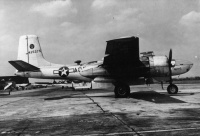44-35617
| A-26C-40-DT Invader | |||
|---|---|---|---|
| Builders: Douglas Aircraft Company | |||
| Operators: United States Air Force | |||
| Number Built: 101 | |||
| First Built: Mar 1945 | |||
| GENERAL CHARACTERISTICS | |||
| Type: Light Attack Bomber | |||
| Wet Weight: 31,000 lbs | |||
| Length: 51' 3" (15.24 m) | |||
| Height: 18' 6" (5.64 m) | |||
| Wingspan: 70' (21.34 m) | |||
| Wing Area: 540 Sq. Feet (50.17 m²) | |||
| Speed: 355 mph | |||
| Max Speed: 370 mph | |||
| Ceiling: 31,300 feet | |||
| Powerplant: 2x Pratt & Whitney R-2800-27 | |||
| Horsepower: 2,000 each | |||
| Fuel Capacity: 1,600 US Gallons | |||
| Range: | |||
| Crew: 3 | |||
| Passengers: 1 | |||
| ARMAMENT | |||
| Nose Guns: 2x .50 Machine Guns | |||
| Dorsal Turret: 2x .50 Machine Guns | |||
| Ventral Turret: 2x .50 Machine Guns | |||
| Payload: 4,000 lbs internal 2,000 lbs wing points | |||
| Donate | |||
| Even a small donation of a couple of dollars goes a long way in helping | |||
"Grim Reaper"
- Although this plane is painted and on display as the letter "N" from the 13th Bomb Squadron in Korea, it never flew with that unit.
This plane was originally slated to be one of the 88 Invaders earmarked for the US Navy. As World War II drew to a close the Navy no longer needed all of them and they were reassigned to other functions.
After a long history of USAF operations, this plane was registered as Civilian under number N600WB. It was later seized by the Los Angeles County Sheriff's Office due to being involved in drug-running. It has since been returned to USAF control and is now a static display at Hill AFB Museum.
Note that some sources, such as Scott Thompson's book "A-26 and B-26 Invaders" and Martin J. Simpson's fantastic website both list this plane as having been registered under the civilian number N7660C. According to Martin's information, the plane was registered under this number sometime between 1957, when it was sent to Davis Mothan AFB, and 1961, when it was registered as N600WB. I have searched the FAA registry for N7660C, but no record ever appears for this plane. According to the FAA Database N7660C was registered 3 times: in 1975 to a Cherokee Piper 32R out of Vero Beach, FL, then in 1976 to a Cherokee Piper 32RT out of Lakeland, FL, and finally in 2007 to a Keith Meyer Odyssey out of Jackson, NJ. I tried searching the FAA Database for the serial number (44-35617), but the only entry that pulls up is N600WB. I am not sure why either Mr. Thompson or Mr. Simpson have come to associate N7660C with this plane, but there is no record to support this.
See also: List of Invaders by Serial Number
Operational History
- USAAF accepted delivery on the aircraft on May 15, 1945.
- May 1945 assigned to the 140th Base Unit at Moody Field, Georgia.
- January 1946 it was assigned to the 4160th Base Unit, Hobbs Field, New Mexico.
- July 1947 came to the 4135th Base Unit at Hill Field, UT.
- Jan 1948 The newly-created United States Air Force re-designated this aircraft as a B-26C
- Jan 1951 moved to the control of the Ogden Air Material Area, still at Hill AFB.
- Nov 1951 transferred to the 117th Reconnaissance Technical Wing (Tactical Air Command) at Lawson AFB, Georgia. That organization moved to Paris in February 1952 and then the following month relocated to Wiesbaden AB, Germany.
- Jun 1952 modified to RB-26C configuration in June 1952.
- Jul 1952 assigned to the 10th Reconnaissance Technical Wing (USAF Europe) at Toul-Rosiere AB, France. While serving with this organization the plane periodically was assigned to Furstenfieldbruck AB, Neubiberg AB, and Erding AB, Germany.
- June 1953 it was transitioned to the 85th Air Defence Wing (USAFE) at Erding AB, Germany.
- July 1953 back to the 10th Reconnaissance Technical Wing (USAFE) at Spangdahlem AB, Germany.
- March 1954 saw the plane move to the 737th Maintenance Group (USAFE) at Chateauroux AB, France.
- April 1954 back to the 10th RTW at Spangdahlem.
- Fall 1955 sent to Manchester, England, for contract maintenance and then was transferred to the 184th Technical Reconnaissance Squadron (Air National Guard) at Ft. Smith, Arkansas.
- 1956 to the 154th Technical Reconnaissance Squadron (ANG) at Adams Field in Little Rock, Arkansas.
- Summer 1957 the aging aircraft was sent to Davis-Monthan AFB in Arizona for long-term storage.
- Jan 1959 dropped from the USAF inventory. Later it was sold to Oklahoma Aircraft Corporation, where it was converted into a light transport for civilian use.
- 1961-1963 Registered as N600WB. Ridge Associates Inc, Flint, MI.
- 1966 Mid America Air Transport, Chicago, IL.
- 1969-1972 Red Dodge Aviation Inc, Anchorage, AK.
- 1977 John Steinmetz, Griffin, GA.
- 6 Jul 1982-1987 Oklahoma Aircraft Corp, Yukon, OK.
- 17 Mar 1983 seized by United States Marshalls in a drug raid in California, carrying a heavy load of marijuana. The Air Force flew the aircraft to Travis AFB, California, where it was placed in temporary storage.
- 3 Jan 1984 a federal judge returned the plane to USAF control, but it remained at Travis for several years. Air Force personnel there repainted the aircraft in original USAF markings and placed it on static display.
- Aug 1990 the plane was disassembled and brought by truck to Hill AFB for restoration and display at Hill Aerospace Museum. The old plane had returned "home" to Hill Field.
- Jan 1991, museum volunteer Roy Marquardt began working with members of the 2849th Combat Logistics Support Squadron from Hill to reassemble and bring this beautiful aircraft back to full military configuration. Since the parts were not available to restore it as an original "C" model, with glazed bombardier nose, it was decided to use the pieces available and rebuild it as a "B" model instead, with a "six-gun" nose. (An "eight-gun" nose was also available, but was in terrible condition due to heavy corrosion.)
Several problems were immediately identified that would have to be overcome to properly restore the aircraft back to its military configuration. Certain parts were missing from the plane, including the wingtips. The civilian version of the plane had been configured with wingtip fuel tanks, but those had been removed sometime between 1984 and 1991 and no wingtips were present at all. New wingtips would have to be fabricated if none could be located.
The plane also had several windows in the fuselage that had been added for the civilian/passenger version. To revert to military configuration these would have to be removed and new skin panels fabricated. Interior lighting and wiring would have to be removed as well. The aircraft also had the wrong type of propellers for either a "B" or "C" model. It had arrived with the paddle-blade type found on the "K" model. The proper slender "pointed" type props would have to be obtained for the "B" version's engines.
Also, the openings in the fuselage for the upper and lower gun turrets were sealed and would have to be reopened to accommodate the rebuilt turrets. The crew access ladder was also missing and its fuselage panel sealed. A new ladder would have to be made, or found, and the access panel reopened. Finally, no machine guns were aboard, of course, so at least cooling jackets would have to be installed in the various gun emplacements to bring back the warbird's "sting."
Restoration work progressed throughout 1991, 1992, and 1993. The wings were hoisted into place, the rudder and elevators attached, and the landing gear bolted on and locked in the down position. The engines were mounted and detailed, cowlings attached, and the gun nose bolted on and made ready to receive gun barrels. The cockpit, which over the years had been converted to dual controls, was reworked back to its proper single-pilot arrangement. (The A-26 was originally manned by a pilot, a navigator/bombardier/loader, and a turret gunner. Sometimes a flight engineer would accompany the standard crew.) The canopy also had to be replaced with an original military version as the civilian variant used a different setup.
The proper wingtips were finally located and purchased from an aircraft parts dealer in Arizona by a member of the Air Force Heritage Foundation of Utah. New tires were installed and machine gun barrels and cooling jackets were put in all gun positions. The proper propellers were discovered at the Air Force Museum at Wright-Patterson Air Force Base, Ohio, who was restoring a "K" model B-26 at the time and happened to need the exact ones at Hill, so a trade was arranged. Also, all required skin panels were reworked, including the fabric skins of the control surfaces, which were replaced with aluminum to prevent future deterioration.
- 1994 the aircraft was towed to the aircraft paint shop on base to await its turn in line for a new finish. The aircraft was painted in the jet black and red scheme of the 13th Bombardment Squadron (Light), "the "Devil's Own Grim Reapers." The 8th, 13th, and 90th Bomb Squadrons comprised the famous 3rd Bombardment Group of the 5th Air Force, which served with distinction in the Pacific Theatre of operations in World War II and later flew missions out of Japan and Kunsan, Korea, during the Korean War.
The 13th Bomb Squadron was originally organized for service in World War I as the 13th Aero Squadron and its skeleton emblem was officially approved by the War Department in 1924. Roy Marquardt, who spearheaded the restoration efforts on this aircraft, was a B-26 crew chief with the "Grim Reapers" in Japan during the Korean War.
- Mar 1995 The freshly refinished aircraft was towed back to the museum and placed in its final resting place for long-term display. Further work on the airframe will include installation of wing-mounted bomb racks and bombs, the crew access ladder, and the upper window fairings on the fuselage aft of the dorsal gun turret. The "Grim Reaper" stands today as a tribute to USAF A-26 flight and maintenance crews who served in two wars, and to the men and women of Hill Field who supported the aircraft for so many years.
Accidents
No Military Accidents found.
No Civil Accidents found. (No FAA, No NTSB, to SDR).
Crew
- Marquardt, Roy - head of the restoration project at Hill Aerospace Museum
Disposition
Static Display at Hill AFB Musuem
Images
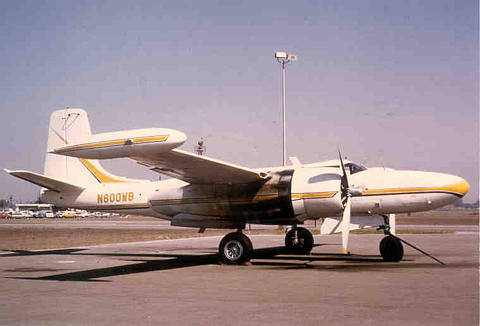
A-26C-40-DT Invader 44-35617 as Civil Registry N600WB. Sometime between 1961 and 1983. Exact date and location unknown. Image credit unknown.
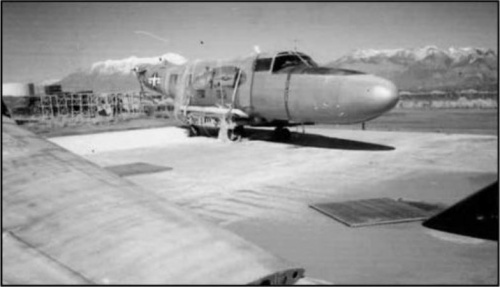
44-35617 arriving in pieces at Hill AFB. Note that although the plane has been painted in USAF colors, it still has the long, unarmed nose of the civilian OnMark conversion. Photo from Roy Marquardt via Invader Magazine.
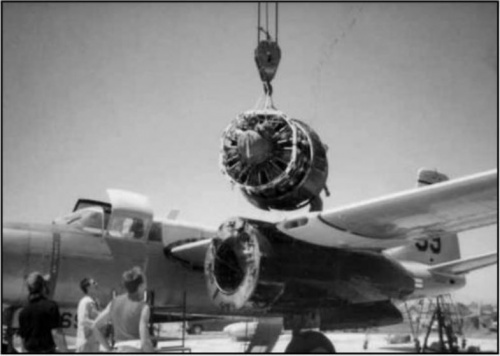
44-35617 under restoration at Hill AFB. The engines are being hosted back into position during the early 1990s. Photo from Roy Marquardt via Invader Magazine.

44-35617 under restoration at Hill AFB. The civilian nose has been replaced with a 6-gun "B" version during the early 1990s. Photo from Roy Marquardt via Invader Magazine.
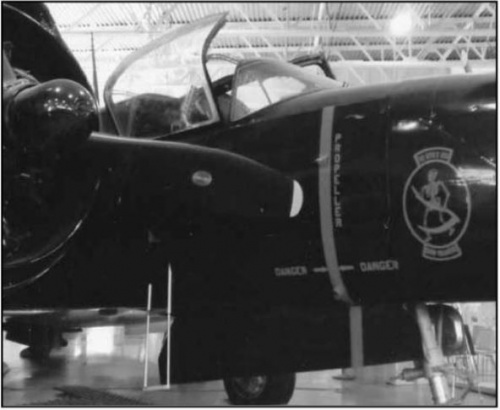
44-35617 on display at Hill AFB. The civilian canopy been replaced with a proper 3rd Generation "clamshell" type during the early 1990s.
"Oscar, the Devil's Own Grim Reaper" is prominently displayed on front right side. Oscar is the mascot of the 13th Bombardment Squadron. Though this plane never flew with the 13th, she was restored a former crew chief of the 13th who wanted to honor the unit. Photo from Roy Marquardt via Invader Magazine.

44-35617 on display at Hill AFB. The rockets here are not actual rockets. They are reproduction props made from PVC, wood, and metal tubing to the specifications of the original rockets. The rockets (and the later PVC bombs) were built by Roy Marquardt and his son, John, during the early 1990s. Photo from Roy Marquardt via Invader Magazine.
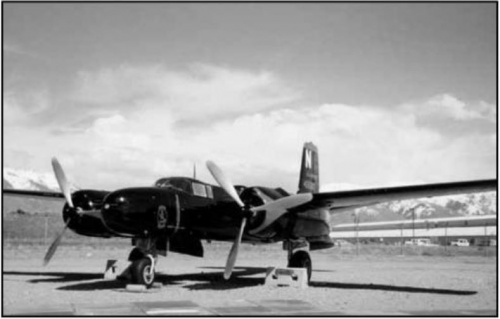
44-35617 on display at Hill AFB. Photo from Roy Marquardt via Invader Magazine.

Invader 44-35617 at Hill Aerospace Museum. USAF.
Sources
Databases searched:
- AAIR - One Entry
- MACR - No Entry
- KORWALD - No Entry
- Baugher
- Hill AFB Museum - https://www.hill.af.mil/About-Us/Fact-Sheets/Display/Article/397299/a-26b-invader/
- Invader Magazine, Jul 2015 (Pg 10-15) - https://www.hill.af.mil/About-Us/Fact-Sheets/Display/Article/397299/a-26b-invader/
